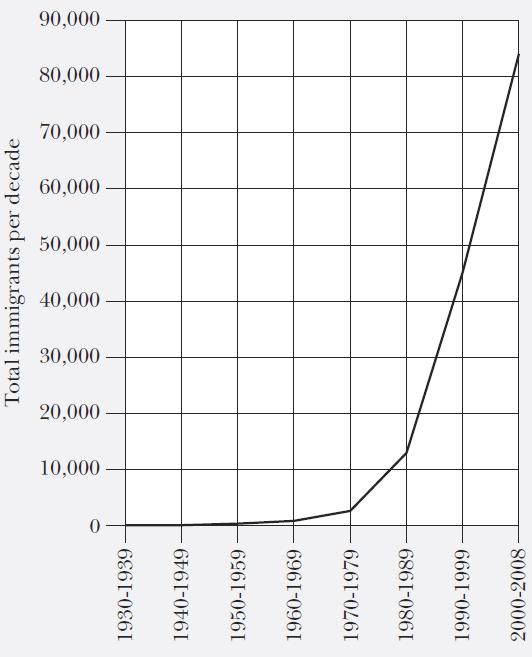Ethiopian immigrants
2011-10-20 02:51:52
Significance: After passage of the 1965 Immigration and Nationality Act, Ethiopians became the third-largest national group of African immigrants to immigrate to the United States. Most arrived in the United States after Congress passed the Refugee Act of 1980.
Ethiopia and its people have long held a special meaning in America. Once known as Abyssinia, Ethiopia stood for black pride and black independence as far back as the 1760’s. Already possessing strong biblical associations, the name “Ethiopia” became an iconic symbol of African independence throughout Europe’s twentieth century colonization of Africa. Some educated African American slaves such as the poets Phillis Wheatley and Jupiter Hammon occasionally identified themselves as “Ethiopians” during the era of the American Revolution. The tendency of black intellectuals to describe themselves as “Ethiopians” stems from the European custom—derived from biblical usage—of applying “Ethiopian” to all peoples from the African interior. This usage, which dates back to the ancient Greeks, can make it difficult to separate immigrants from the actual Northeast African nation of Ethiopia fromthe masses of African Americans.
The first Ethiopian immigrants to reach North America probably arrived as slaves sometime during the seventeenth century. However, the bulk of voluntary immigrants to the United States came after 1974, when a repressive regime toppled the ancient monarchy and took control of the Ethiopian government. The ensuing exodus from Ethiopia, a landlocked nation on the northeastern Horn of Africa, resulted from political turmoil as well as famine and drought. Many refugees fled initially to settlement camps in the neighboring Sudan before moving on to the United States. Impoverished, the Sudan offered few economic opportunities, while the United States held out the hope of a prosperous future.Until Somalis surpassed them in 1994, Ethiopians were the largest group of Africans to immigrate under the provisions of the Refugee Act of 1980.
Immigration from Ethiopia, 1930-2008
 Source: Department of Homeland Security, Yearbook of Immigration Statistics, 2008. Figures include only immigrants who obtained legal permanent resident status.
Source: Department of Homeland Security, Yearbook of Immigration Statistics, 2008. Figures include only immigrants who obtained legal permanent resident status.
Ethiopian immigrants to the United States have differed from many other immigrant ethnic groups in that they typically arrived with a basic command of British English and tended to settle in disparate neighborhoods, instead of gathering in ethnic enclaves. The consequent lack of cohesive immigrant communities has complicated their efforts to maintain language and cultural ties to their homeland. Also, racism has been a new experience, with many exposed to the color line for the first time in the United States.
Profile of Ethiopian immigrants
| Country of origin | Ethiopia |
| Primary language | Amharic |
| Primary regions of U.S. settlement | Los Angeles, New York City |
| Earliest significant arrivals | Seventeenth century |
| Peak immigration period | 1980’s |
| Twenty-first century legal residents* | 8,004 (1,000 per year) |
*Immigrants who obtained legal permanent resident status in the United States.
Source: Department of Homeland Security, Yearbook of Immigration Statistics, 2008.
Most Ethiopian immigrants are Coptic Christians and Muslims, and their religions have served as sources of comfort in the New World, with churches and mosques serving as community centers, health centers, and social services providers. During the early twenty-first century, the population of Ethiopia was almost evenly divided between Christians and Muslims, a split that is reflected among the immigrants to America. Ethiopia has also long had a significant Jewish population, but most of its Jews emigrated to Israel, while the bulk of other refugees fled to the United States. Ethiopians in America have subsequently established the Ethiopian Orthodox churches as well as the Bilal Ethiopian mosques.
Caryn E. Neumann
Further Reading
- Getahun, Solomon Addis. The History of Ethiopian Immigrants and Refugees in America, 1900-2000. New York: LFB Scholarly Publishing, 2006.
- Olupona, Jacob K., and Regina Gemignani, eds. African American Religions in America. New York: New York University Press, 2007.
- Scott, William R. The Sons of Sheba’s Race: African- Americans and the Italo-Ethiopian War, 1935-1941. Bloomington: Indiana University Press, 1993.
See also: African Americans and immigrants; African immigrants; History of immigration after 1891; Immigration and Nationality Act of 1965; Refugees.
- People
- Immigrant groups
- Labor
- Nativism
- Civil rights and liberties
- Cities
- Culture
- Refugees and displaced persons
- Court cases
- Illegal immigration
- Advocacy organizations and movements
- Health
- Arts and music
- European immigrants
- Anti-immigrant movements and policies
- African immigrants
- Citizenship and naturalization
- States
- Asian immigrants
- Agricultural workers
- Children
- Immigration reform
- Laws
- East asian immigrants
- Borders
- Deportation
- Events and movements
- International agreements
- Mexican immigrants
- Education
- Emigration
- Theories
- Ethnic enclaves
- Latin american immigrants
- Business
- Science and technology
- Government agencies and commissions
- Politics and government
- Family issues
- Women
- Economic issues
- Southeast asian immigrants
- Canadian immigrants
- Push-pull factors
- Transportation
- Slavery
- Philanthropy
- Religion
- Demographics
- Research
- Assimilation
- Literature
- Subversive and radical political movements
- Communications
- Journalism
- Language issues
- Crime
- Violence
- Military
- Wars
- Law enforcement
- West indian immigrants
- Stereotypes
- Symbols
- Land
- Psychology
- South and Southwest Asian immigrants
- Pacific Islander immigrants
- Colonies and colonial regions
- Legislation and regulations
- Canada
- United States
- War and immigration
- Administration
- Hispanic issues and leaders
- Treaties
- Economics and commerce
- Immigration policy
- Religion
- Colonial founders and leaders
- Explorers and geographers
- France
- Political figures: Canada
- Political figures: United States
- Race and ethnicity
- Reformers, activists, and ethnic leaders
- Women